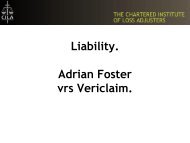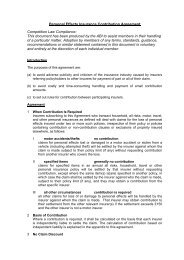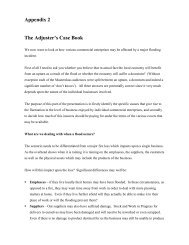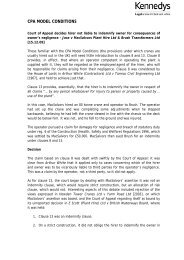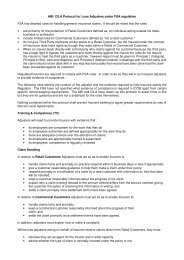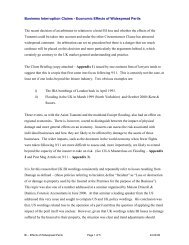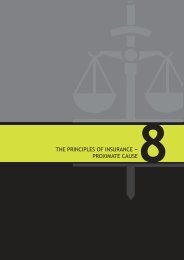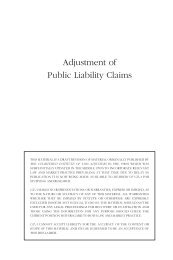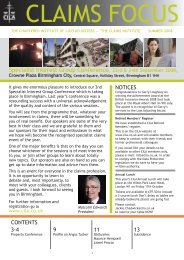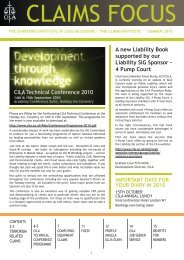Flood resilience and resistance factsheet for insurers and loss ...
Flood resilience and resistance factsheet for insurers and loss ...
Flood resilience and resistance factsheet for insurers and loss ...
- No tags were found...
Create successful ePaper yourself
Turn your PDF publications into a flip-book with our unique Google optimized e-Paper software.
3 FLOOD RESILIENCE AND RESISTANCERestoring a property after flood damage using acombination of flood-resilient <strong>and</strong> flood-resistanttechniques could reduce the costs of future flooding<strong>for</strong> that propertyWhy promote flood resilient repair?Restoring a property after flood damageusing a combination of flood-resilient<strong>and</strong> flood-resistant techniques couldreduce the costs of future flooding<strong>for</strong> that property 1 .• <strong>Flood</strong> <strong>resilience</strong> – reduces damagecaused by any water that gets insidethe property• <strong>Flood</strong> <strong>resistance</strong> – reduces the amountof water that gets inside the propertyBoth could allow insurance to remainavailable to the customer, in line with theABI Statement of Principles 2 , <strong>and</strong> couldeven influence future premiums chargedor terms applied.The issue of flood <strong>resilience</strong> <strong>and</strong> <strong>resistance</strong>is rising in prominence. The Government isnow considering the feasibility of usingflood-resilient repair <strong>and</strong> installing floodresistantmeasures as additional options<strong>for</strong> the long-term management of floodrisk. Many are looking to the insuranceindustry, with its direct link to customerswho have been flooded, to help encouragegreater uptake of such measures,particularly during repair.There are more than two millionproperties at risk of flooding in the UK,with approximately one quarter of theseproperties at significant risk of flooding(greater than 1.3% annual probabilityor 1-in-75 year chance). Even with thesubstantial increases in Governmentinvestment in flood management since2002, large numbers of properties couldremain at significant risk of flooding.These properties will mostly be in ruralor isolated areas, which may be too costlyto defend using capital flood protectionschemes, given the relatively low numberof properties benefiting.1 Preparing <strong>for</strong> floods ODPM October 2003.http://www.odpm.gov.uk/pub/112/Preparing<strong>for</strong>floorguidePDF587Kb id1131112.pdf2 ABI Statement of Principles on the provision of floodinsurance, Association of British Insurers, November 2005.http://www.abi.org.uk/Display/File/Child/553/statementofprinciples2005.pdf
4 FLOOD RESILIENCE AND RESISTANCEWhen are flood-resilient repairs<strong>and</strong> flood-resistant measuresappropriate?There is a growing range of simpleproducts <strong>for</strong> keeping low-levelfloodwater out of a property. For deeperor more prolonged periods of flooding,water could still enter through the floor<strong>and</strong> brick/blockwork walls <strong>and</strong> speciallydesigned systems are usually required toprovide flood <strong>resistance</strong>, so it may alsobe advisable to use these in conjunctionwith a pump <strong>and</strong> a sump. In these cases,making the inside of the propertyresilient to floodwater may be morecost effective.<strong>Flood</strong> <strong>resilience</strong> could limit damagecosts <strong>and</strong> reduce the amount of timethe property may be uninhabitable.For floods deeper than one metre,you should allow water to enter theproperty to prevent any structuraldamage that could be caused by abuild up of water outside.The chance of flooding to a property<strong>and</strong> the likely depth of water will bothbe key factors determining of the scale<strong>and</strong> nature of flood-resilient repair thatis most appropriate.A flood risk assessment (responsibility ofthe customer) should be used to ascertainthe level of flood-resilient repair that isappropriate <strong>for</strong> the property. The CIRIAguide on flood repairs provides a veryuseful decision-making process that linksrisk levels to appropriate scale of repair 3 .For properties that will continue to havea significant risk of flooding, it could becost-effective to repair a flooded propertywith a comprehensive suite of floodresilienttechniques. <strong>Flood</strong> claims <strong>for</strong> theseproperties could range from £15,000 -£45,000, compared with £5,000 - £30,000<strong>for</strong> a resilient property.Most properties that have been floodedcould benefit from some degree of floodresilientrepair. Some resilient techniquesdo not cost substantially more than like<strong>for</strong>-like,<strong>and</strong> could be appropriate to repaira range of flooded properties.3 St<strong>and</strong>ards <strong>for</strong> The Repair of Buildings following <strong>Flood</strong>ing.CIRIA 2005 http://www.ciria.org/acatalog/C623.html
5 FLOOD RESILIENCE AND RESISTANCEWhat types of flood-resilientrepair are effective?For properties vulnerable to repeatedflooding, it is important to limit damagecosts <strong>and</strong> reduce the amount of time theproperty is uninhabitable by making theinside of the property more resilient tofloodwater damage. This could involveusing repair specifications that willprovide some advantage in reducingwater damage to walls, floors, <strong>and</strong>fixtures. By re-organising the insideof the property some valuable <strong>and</strong>functional items (including servicemeters <strong>and</strong> boiler) could be raisedabove the likely level of a future flood.Some flood-resilient measures do notcost much more than like-<strong>for</strong>-like,including moving services (electrics,boilers, <strong>and</strong> service-meters) well abovelikely flood level, <strong>and</strong> could be used <strong>for</strong>the repair of all properties that have beenflooded. This technique will typically costless than £1,000 extra <strong>for</strong> the repair, <strong>and</strong>could save more than £2,500 after thenext flood.Other measures are more costly thanconventional repair, but will often pay<strong>for</strong> themselves after a single flood, i.e. theextra cost of installing flood <strong>resilience</strong> maybe more than offset by the damage costssaved after the next flood. Examples include:• Replacing gypsum plaster with morewater-resistant material, such as lime plasteror cement render <strong>and</strong> renovating plaster• Installing water-resistant doors <strong>and</strong>window-frames (e.g. plastic or waxedgood-quality hardwood, where appropriate)• Replacing the usual chipboard kitchenor bathroom units with plastic or steelequivalents (where these are appropriate<strong>and</strong> cost-effective), e.g. plastic kitchenunits with removable, waxed goodqualitywooden doors• Replacing timber floors with solidconcrete (only where appropriate), usingtiles <strong>and</strong> a water-proof membrane toprevent water penetration into concrete• Removing patio doors <strong>and</strong> installingconventional doors <strong>and</strong> windows withbrickwork construction underneath• Installing one-way valves into drainagepipes to prevent sewage backing up intothe houseSpecialist advice should always beobtained be<strong>for</strong>e repairs are commissioned.By carrying out these measures, theproperty could be cleaned, dried, repaired<strong>and</strong> re-occupied more quickly, reducingdisruption to the customer <strong>and</strong> minimisingcosts to <strong>insurers</strong>. Some evidence suggestscustomers could only be out of their house<strong>for</strong> 3 - 4 weeks instead of 6 months,depending on the depth of flooding.Installing the full suite of measures couldadd £10,000 - £15,000 to the cost ofrepair, but may save at least £5,000 -£12,000 in each subsequent flood 4 .What about flood protectionproducts?<strong>Flood</strong>-resilient repair can be combinedwith a range of flood-protectionproducts to attempt to limit:1. Amount of water that enters the property2. Costs to repair material damage3. Amount of time the customer is outof their propertyThere is a growing range of products <strong>for</strong>keeping water out of a property. Somehave been awarded the British St<strong>and</strong>ardsInstitute “Kitemark”, <strong>and</strong> some havealready proved to be effective in actualflood situations. A full list of accreditedproducts is available from theEnvironment Agency.The most common individual propertylevelproducts include aperture protectionsuch as door-guards, <strong>and</strong> airbrick coverssuitable <strong>for</strong> short duration flooding, <strong>and</strong>building “skirt systems” that caneffectively isolate the whole propertywhen flooding is more prolonged. Thesecan only protect a property up to a certaindepth of water. Brick-walls will usuallyonly keep the floodwater at bay <strong>for</strong> ashort period between 20 - 60 minutesbut they can buy valuable time. There mayalso be some l<strong>and</strong>scaping options <strong>for</strong> theoutside of the property, including bundingwalls <strong>and</strong> gates with seals, extra ditches<strong>for</strong> drainage <strong>and</strong> garden l<strong>and</strong>scaping.There are now systems available thatcan provide comprehensive solutions toprevent water from entering the propertyin a prolonged flood.Typically costs of property-level floodprotectionusing aperture protection canrange from £2,000 - £6,000 to deal withlikely flash-floods. Dealing with prolongedflooding on larger individual propertiescan cost between £20,000 - £40,000,depending on the scale <strong>and</strong> sourcesof floodwater entering the property.Indications from the limited studiescurrently available have shown thatappropriate flood protection couldreduce claims costs by 50 - 80%.Further details on the most appropriatemeasures <strong>for</strong> the home are available fromthe <strong>Flood</strong> Protection Association <strong>and</strong> theEnvironment Agency 5 .
6 FLOOD RESILIENCE AND RESISTANCEWho pays <strong>for</strong> any additional costsof <strong>resilience</strong> or <strong>resistance</strong>?One of biggest misconceptions aboutflood-resilient repair is that all theadditional cost will fall on <strong>insurers</strong>.The ABI has made it clear that membersare willing to work with customers inreinstating their homes to flood-resilientst<strong>and</strong>ards following damage, providedthis is cost-neutral. If the cost of floodproofingis substantially greater thanthe st<strong>and</strong>ard repair, then <strong>insurers</strong> willonly provide funds to cover thest<strong>and</strong>ard repair.However, there are now some goodoptions available to households to coverextra costs. In addition to householderscovering the balance from savings, theCouncil <strong>for</strong> Mortgage Lenders haveconfirmed that many lenders are willingto consider extending mortgages to coverthe additional costs of repairs providedthe homeowner has sufficient equity.You should advise customers to talkto their lender about this.In addition, the Government is lookinginto the feasibility of offering financialsupport <strong>for</strong> pilot studies 6 to install floodresilient<strong>and</strong> flood-resistant measures inappropriate properties. The WelshAssembly Government <strong>and</strong> some localcouncils (e.g. Carlisle) have alreadyestablished pilot grant schemes <strong>for</strong>property-level measures.In the long term, adopting such measurescould make it easier <strong>for</strong> an insurer tocontinue to provide cover to a homeownerliving in a high flood-risk area (in line withthe ABI Statement of Principles). Therecould even be a possibility of improvedterms if a comprehensive system of floodprotection is undertaken <strong>and</strong> the impacton flood risk properly assessed.How to make flood-resilientrepair happen?For properties in areas of significantflood risk where flood-<strong>resilience</strong> <strong>and</strong>flood-<strong>resistance</strong> are most appropriate,the <strong>loss</strong> adjuster should discuss optionswith the customer. Many customerswill not know that they could havetheir property repaired in a floodresilientmanner. This should be madeclear to them at the start of the repairprocess. The ABI has prepared acomplementary <strong>factsheet</strong> “Repairingyour home or business after a flood –how to limit damage <strong>and</strong> disruption inthe future” (jointly with the National<strong>Flood</strong> Forum). Copies can be downloadedfrom the website <strong>and</strong> should be passedon to flooded customers. Alternatively,<strong>insurers</strong> <strong>and</strong> <strong>loss</strong> adjusters may chooseto badge the publication jointly <strong>and</strong>distribute through their own channels.The different options should be discussedwith the customer, including implications<strong>for</strong> any costs that will fall directly to them.Claims-h<strong>and</strong>lers may also like to liaisewith underwriting colleagues to discussimplications on the customer’s futureinsurance premium/excess.Be<strong>for</strong>e undertaking major renovations,it is essential to get advice from aspecialist, who could undertake acomprehensive flood risk assessment<strong>and</strong> recommend an appropriate set ofmeasures <strong>for</strong> the property. The tablein the customer <strong>factsheet</strong> identifieskey organisations whose members couldprovide such a service. Any repairs canbe undertaken in a way that is sympatheticto the style, character <strong>and</strong> period ofthe property.<strong>Flood</strong> risk assessments are best consideredat an early stage in the flood-repairprocess when the effects of the flood arestill at the <strong>for</strong>efront of the customer’s mind.The <strong>Flood</strong> Protection Association hasrecently developed a service, which isprofessionally indemnified, to undertakeflood risk assessments <strong>and</strong> designappropriate solutions. This service aimsto provide a cost-effective protectionsolution to deal with properties atsignificant risk of flooding.4 <strong>Flood</strong> Resilient Homes, Association of British Insurers, April2004. http://www.abi.org.uk/Display/File/Child/553/<strong>Flood</strong>_Resilient_Homes.pdf5 Damage Limitation Guide, Environment Agency.http://www.environmentagency.gov.uk/subjects/flood/826674/830330/8769706 First Government response to Making space <strong>for</strong> waterconsultation, Department <strong>for</strong> Environment, Food <strong>and</strong> RuralAffairs, March 2005. http://www.defra.gov.uk/environ/fcd/policy/strategy/msw1exec.pdf
For more in<strong>for</strong>mation, contact:Association of British Insurers51 Gresham StreetLondon EC2V 7HQ020 7600 3333The Chartered Institute of Loss AdjustersPeninsular House36 Monument StreetLondon EC3R 8LJ020 7337 9960 / 0845 3459 960www.abi.org.ukwww.cila.co.uk



